How to Incorporate Natural Materials in Kitchen Design
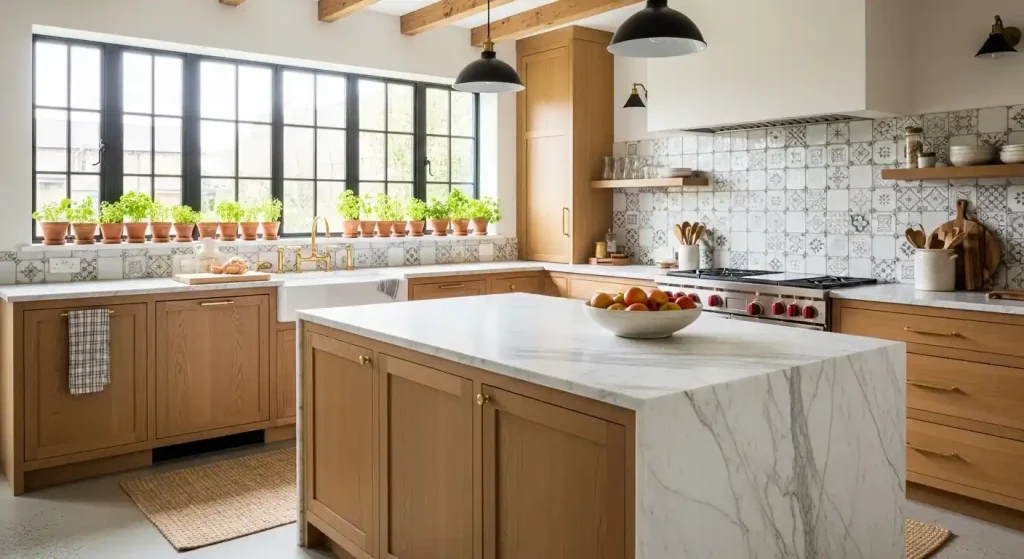
Designing a kitchen is about more than just choosing cabinets and countertops—it’s about creating a space that feels warm, inviting, and timeless.
One of the most effective ways to achieve this is by incorporating natural elements into the design.
Natural materials bring texture, character, and a sense of calm to the heart of your home.
From wood accents to stone surfaces, these elements connect your kitchen to nature while offering durability and style.
🎃 Spooky Good Amazon Deals This Fall !
From cozy fall essentials to Halloween must-haves, shop Amazon’s seasonal discounts now. Don’t wait, deals vanish fast!
*As an Amazon Associate, I earn from qualifying purchases.
In this guide, we’ll explore practical and inspiring ways to use natural materials in kitchen design, ensuring your space feels both functional and beautiful.
Why Choose Natural Materials in Kitchen Design?
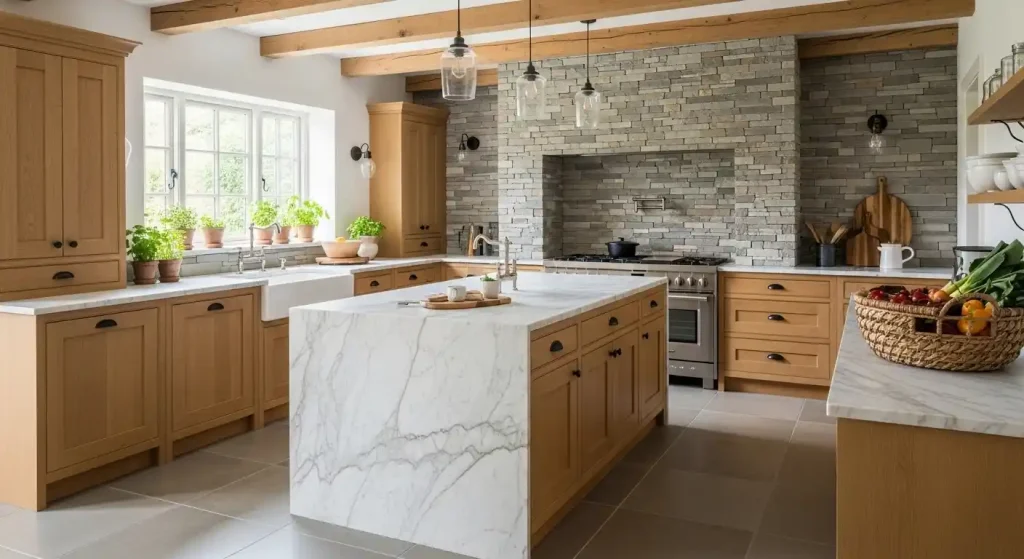
Natural materials aren’t just aesthetically pleasing—they’re also sustainable and long-lasting.
Wood, stone, clay, and natural fibers age gracefully, often becoming more charming over time.
Unlike synthetic alternatives, they bring authenticity and depth to a space.
Choosing organic elements also helps create a healthier environment.
Natural surfaces like stone or butcher block don’t off-gas harmful chemicals, making your kitchen safer for cooking and gathering.
Plus, these materials complement nearly every style, from rustic farmhouse kitchens to sleek modern spaces.
By blending natural textures with thoughtful design, you can create a kitchen that feels timeless and deeply personal.
Wood: The Heart of a Natural Kitchen
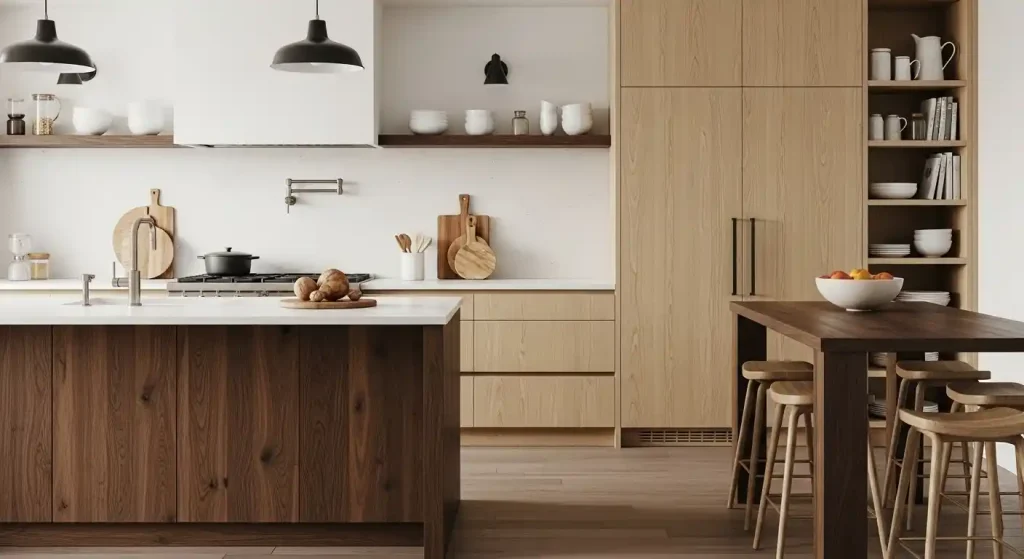
Wood is one of the most versatile materials you can use in your kitchen. From cabinetry to open shelving, it instantly adds warmth and richness.
Lighter woods like oak or maple create an airy, Scandinavian feel, while darker tones like walnut bring depth and elegance.
Consider mixing finishes for a layered look—for example, pairing light wood cabinets with a darker wood island.
Even small touches, such as wooden cutting boards or bar stools, can make a big impact.
🎃 Spooky Good Amazon Deals This Fall !
From cozy fall essentials to Halloween must-haves, shop Amazon’s seasonal discounts now. Don’t wait, deals vanish fast!
*As an Amazon Associate, I earn from qualifying purchases.
For a sustainable choice, look for reclaimed or FSC-certified wood.
These options not only reduce environmental impact but also add unique character with their natural imperfections and grain patterns.
Stone Countertops and Backsplashes
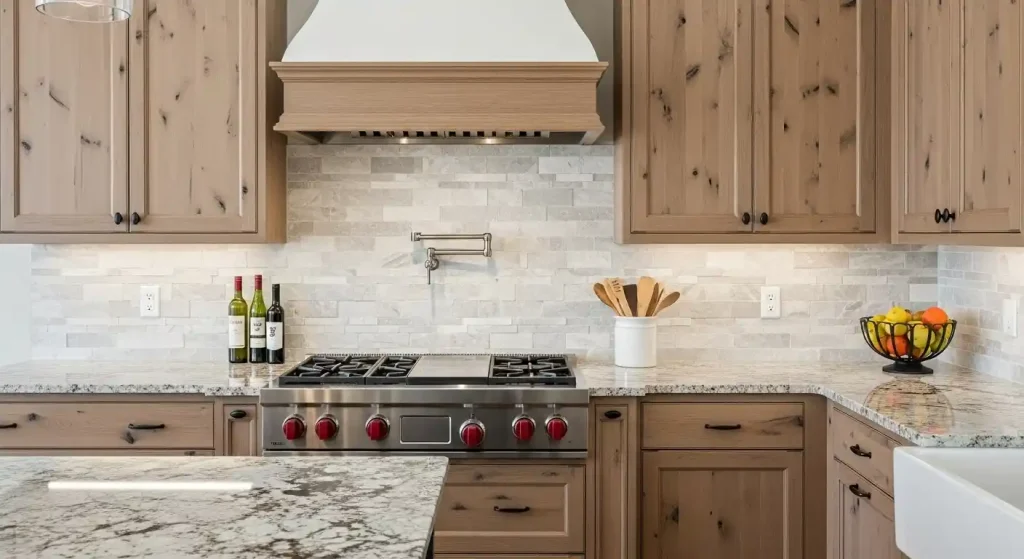
Stone is another cornerstone of natural materials in kitchen design.
Granite, marble, soapstone, and quartzite each bring unique colors and textures that elevate a kitchen’s look.
Marble offers timeless elegance with its veined patterns, while granite provides durability and bold character.
Soapstone, with its soft matte finish, develops a beautiful patina over time, making it ideal for those who love a lived-in charm.
Beyond countertops, stone backsplashes can create a striking focal point.
A full slab backsplash adds luxury, while stacked stone tiles bring rustic texture. Pair stone with wood cabinetry for a balanced, organic aesthetic.
Natural Flooring Choices
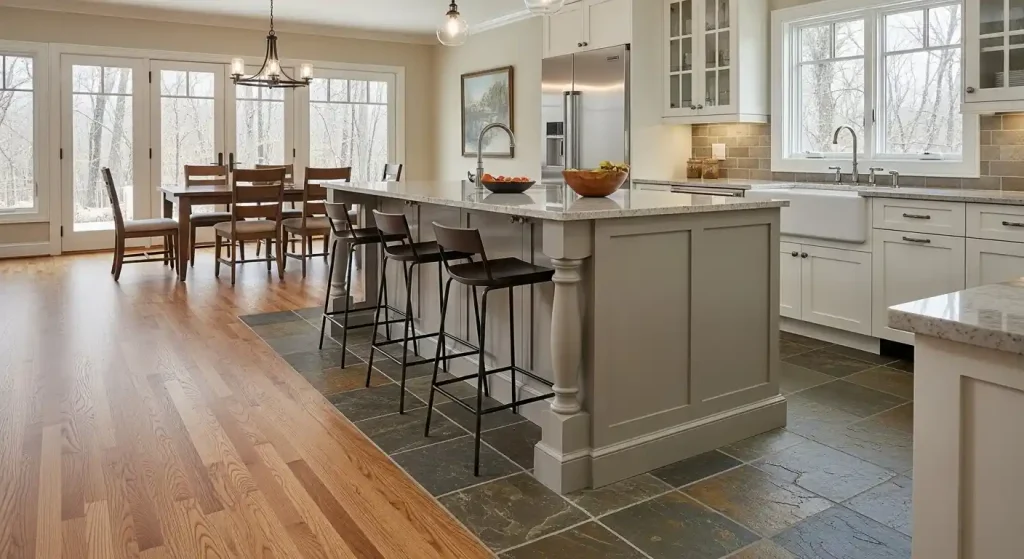
Flooring sets the tone for your entire kitchen, and natural materials make a big difference.
Hardwood floors are a classic option, offering warmth and continuity throughout open-plan homes.
If you prefer something more durable, natural stone tiles like slate or travertine are excellent choices.
They’re resilient, easy to clean, and add earthy character.
🎃 Spooky Good Amazon Deals This Fall !
From cozy fall essentials to Halloween must-haves, shop Amazon’s seasonal discounts now. Don’t wait, deals vanish fast!
*As an Amazon Associate, I earn from qualifying purchases.
For a softer feel underfoot, cork and bamboo are eco-friendly alternatives that bring warmth while being gentle on the environment.
Whichever material you choose, natural flooring grounds your kitchen design and connects it to the rest of your home in a seamless way.
Incorporating Natural Fibers
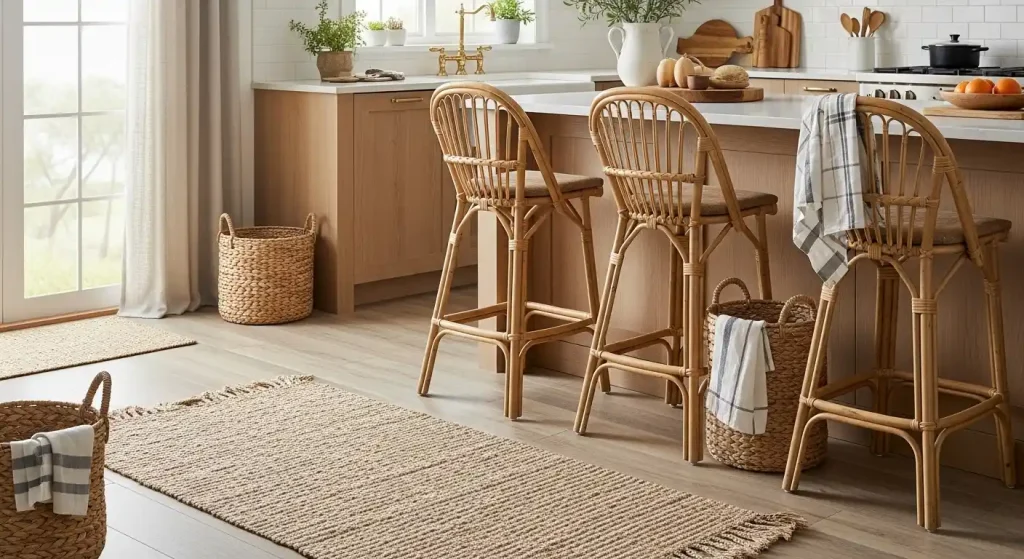
Natural fibers may not be the first thing you think of in a kitchen, but they add subtle texture and charm.
Woven baskets, jute rugs, and rattan bar stools introduce organic elements without overwhelming the space.
These materials are also practical. Baskets provide stylish storage for produce or kitchen towels, while rugs soften hard flooring and define zones in open kitchens.
Even small touches—like linen curtains or cotton dish towels—can make your kitchen feel more natural and inviting.
Together, these fibers complement wood and stone, creating a layered, cohesive look.
The Power of Greenery
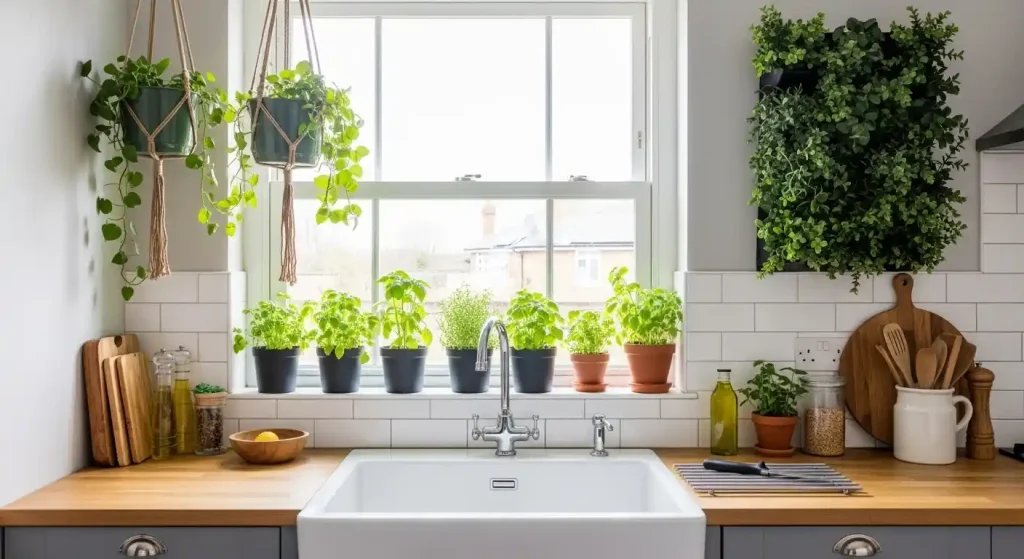
Plants are one of the simplest ways to bring life into your kitchen.
Fresh herbs on the windowsill not only look beautiful but also provide convenient access while cooking.
Larger potted plants or trailing vines can soften hard edges and add vibrancy to the space.
🎃 Spooky Good Amazon Deals This Fall !
From cozy fall essentials to Halloween must-haves, shop Amazon’s seasonal discounts now. Don’t wait, deals vanish fast!
*As an Amazon Associate, I earn from qualifying purchases.
Greenery pairs perfectly with other natural materials, enhancing the organic atmosphere.
Consider hanging planters, wall-mounted herb gardens, or even a vertical green wall if you have the space.
Beyond aesthetics, plants improve air quality and create a calming environment—making your kitchen feel like a true sanctuary.
Lighting with Natural Materials
Lighting is often overlooked, but it plays a key role in setting the mood.
Fixtures made from natural materials like wood, rattan, or clay bring warmth and texture to your kitchen’s design.
Pendant lights with woven shades can add a coastal or bohemian vibe, while ceramic sconces offer a handcrafted touch.
Even metal fixtures with natural finishes, such as aged brass or copper, complement organic design elements beautifully.
Pair natural lighting fixtures with plenty of natural light from windows or skylights to create a bright, welcoming atmosphere.
The combination of sunlight and earthy textures makes the kitchen feel alive and inviting.
Blending Modern and Natural Elements
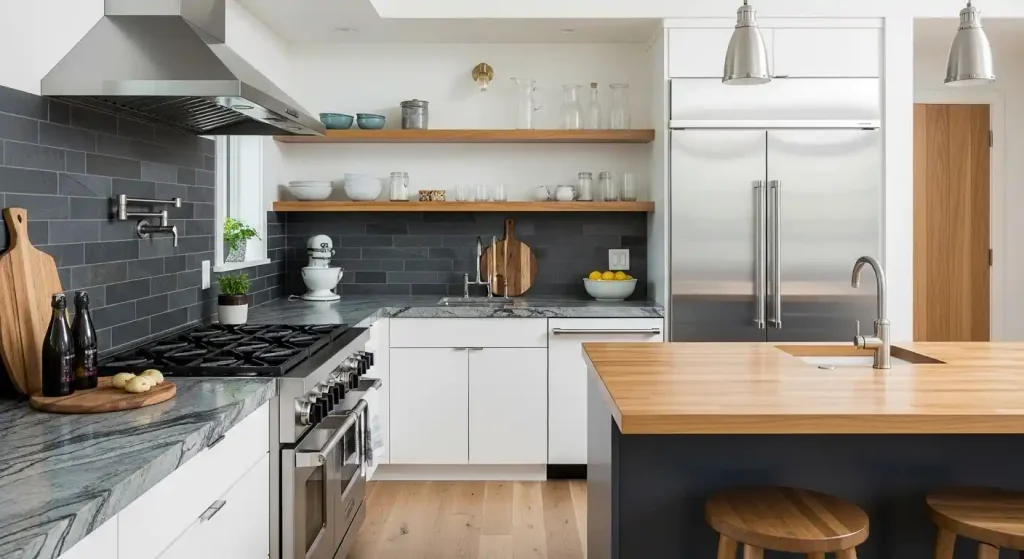
You don’t have to choose between sleek modern design and organic charm—you can have both.
The key is balance. Pair streamlined cabinetry with a natural stone countertop, or mix stainless steel appliances with warm wood accents.
Minimalist kitchens benefit from the texture and depth that natural materials provide.
🎃 Spooky Good Amazon Deals This Fall !
From cozy fall essentials to Halloween must-haves, shop Amazon’s seasonal discounts now. Don’t wait, deals vanish fast!
*As an Amazon Associate, I earn from qualifying purchases.
For example, a clean white kitchen feels less sterile when paired with a butcher block island or a slate backsplash.
This blend of modern and natural ensures your kitchen feels fresh and stylish while staying grounded in timeless design principles.
Color Palettes Inspired by Nature
The colors you choose can enhance the natural feel of your kitchen.
Earthy tones—such as soft greens, warm browns, and muted grays—create a soothing backdrop for organic materials.
Neutral palettes work especially well when layered with wood and stone, allowing their natural textures to shine.
For a bolder look, consider deep forest green cabinets or terracotta tiles, which bring richness and warmth.
By drawing inspiration from nature’s palette, you can create a kitchen that feels harmonious and connected to the outdoors.
Small Touches with Big Impact
You don’t need a full renovation to bring natural materials into your kitchen. Start with small, intentional updates.
Wooden cutting boards, stone serving platters, or ceramic dishware can instantly make the space feel more organic.
Switching out synthetic textiles for linen or cotton adds softness, while displaying fresh flowers or herbs brings life.
Even changing hardware to natural finishes like brass or bronze can subtly enhance the design.
These small details may seem simple, but together they transform your kitchen into a space that feels authentic and welcoming.
Sustainability and Longevity
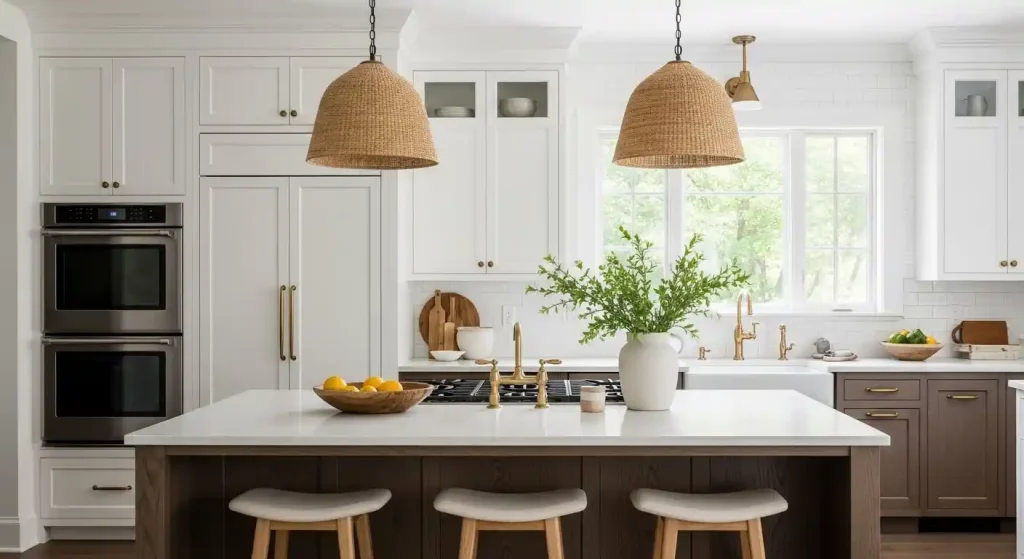
One of the greatest benefits of natural materials is their sustainability.
Unlike synthetic products that wear out quickly, wood, stone, and natural fibers often last for decades.
Many can be refinished, repurposed, or recycled, reducing waste and environmental impact.
Investing in natural materials also adds long-term value to your home.
Buyers are increasingly drawn to kitchens that feature authentic, eco-friendly design choices.
By prioritizing quality and sustainability, you create a space that’s both beautiful and responsible.
Final Thoughts
Incorporating natural elements into your kitchen design is about more than just style—it’s about creating a space that feels warm, grounded, and timeless.
From wood cabinetry to stone countertops, natural fibers to greenery, each element contributes to a kitchen that’s both functional and inviting.
Whether you’re planning a full renovation or just want to refresh your space with small updates, using natural materials in kitchen design ensures your kitchen reflects the beauty of the natural world.
Start small, experiment with textures, and let nature guide your choices.
The result will be a kitchen that feels authentic, sustainable, and truly yours.
